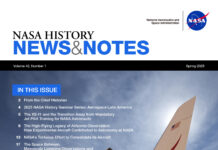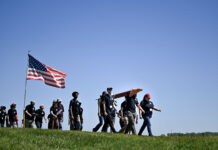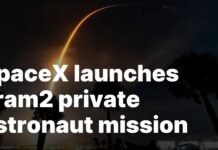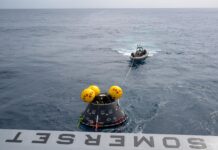Safety Woven Throughout the Fabric of Marshall: NASA’s Marshall Space Flight Center Safety Day
NASA’s Marshall Space Flight Center held its annual Safety Day on September 26, with the theme “Safety Woven Throughout the Fabric of Marshall.” This event underscores the importance of integrating safety into every aspect of work and daily life. The kickoff activities were held in Building 4316 and various other locations around the center.
Marshall Director Joseph Pelfrey emphasized the importance of safety in his opening remarks. He stated, “It is crucial to ensure that each of us weaves safety into everything we do, not only at work but in our daily lives.” This sentiment reflects the center’s commitment to maintaining a safe working environment and culture.
The tradition of Safety Day at NASA began after the space shuttle Columbia accident in 2003. Each center within the agency dedicates a day annually for team members to reflect on the importance of safety in their work environment. This year’s Safety Day at Marshall started with a breakfast sponsored by Jacobs and Bastion Technologies, followed by a welcome address from Bill Hill, Director of the Safety and Mission Assurance Directorate at Marshall.
Pelfrey highlighted the center’s emphasis on transparency and its role in fostering a safe work environment. “Over the past year, Marshall’s leadership and workforce have highlighted that transparency is an essential cultural attribute of our workforce and center,” he said. “It is also important to our core value of safety. Transparency fosters an environment where employees feel comfortable in reporting potential risks or safety concerns without fear of retribution. This openness ensures that issues are addressed early. It builds trust and accountability within our workforce, center, NASA, and external stakeholders.”
The event featured a guest speaker, Marceleus Venable, a purpose coach, trainer, and author, who encouraged team members to prioritize their physical and mental health. He also urged them to appreciate their hard work and that of their colleagues at Marshall. NASA astronaut Mark T. Vande Hei was the keynote speaker, highlighting the importance of teamwork in NASA’s safety mission. “We need a lot of talented team players to meet the challenges that we have for future space flights,” said Vande Hei. “Always try to do your best, but make sure that other people around you are doing their best as well and help them do that rather than you standing out as always being the best.”
Micah Embry, the Safety Day 2024 chairperson, presented Vande Hei with a certificate for his participation. Additionally, during the event, Bill Hill awarded the Golden Eagle Award to Peter Wreschinsky, a Jacobs Space Exploration Group employee. The award is part of the Mission Success is in Our Hands safety initiative, a collaboration between Marshall and Jacobs.
Over 400 civil servants and contractors participated in Safety Day, with various organizational and vendor booths providing information on a range of safety topics, including Emergency Management Services, fire protection, storm shelters, and more. Pelfrey concluded the event by emphasizing the continuous improvement of safety procedures. “As Marshall continues to be a leader at NASA and across the aerospace industry, we must always be looking forward to improve our procedures and anticipate potential hazards,” he said. “Safety is directly tied to our mission success. Without safety, we cannot achieve the goals we set for ourselves in space exploration, research, and innovation.”
Highlighting Lander Systems: Marshall’s Role in Lunar Exploration
For the month of September, NASA’s Marshall Space Flight Center featured Lander Systems, which plays a crucial role in the Human Landing System (HLS) Program. This program is essential for safely landing humans on the Moon and eventually Mars, as part of the agency’s Artemis campaign. NASA has selected SpaceX’s Starship HLS for Artemis III and Artemis IV, while Blue Origin’s Blue Moon lander will be used for Artemis V. Having two distinct lunar lander designs ensures robustness and a regular cadence of Moon landings.
NASA collaborates closely with industry partners to mature these landers, ensuring astronaut safety and mission success. The Artemis program aims to land the first woman, first person of color, and first international partner astronaut on the lunar surface, advancing key science and discovery.
Amy Buck, who has been with Marshall for ten years, is excited to be part of the Artemis Generation. She is the materials discipline lead for HLS and has the chance to work on nearly every piece of hardware for the two landers. “The NASA HLS materials team is vital in supporting the design, testing, and manufacturing of the landers,” Buck said. She is particularly enthusiastic about seeing the first woman land on the Moon, hoping it will inspire the next generation of engineers and scientists.
Sean Underwood, the thermal discipline lead for HLS, is responsible for ensuring the lunar landers can operate in the Moon’s harsh environment. “There are unique thermal challenges associated with the Artemis III, IV, and V missions,” Underwood said. “Our primary objective is to manage thermal energy and heating rates, ensuring that HLS components and systems remain within thermal limits across all mission environments.” Underwood joined Marshall in 2020 and sees his role with Artemis as shaping the future of space exploration and Marshall. “Through Artemis, we are ensuring that the legacy of past missions continues to inspire and drive us forward,” he said.
Tackling Energy Efficiency: Marshall’s New Thermal Energy Storage Tank
Maintaining energy costs while keeping cool during the sweltering summer months is a significant challenge for any facility, including NASA’s Marshall Space Flight Center. However, a new infrastructure upgrade at Marshall is set to reduce the center’s utility costs by approximately $250,000 a year, shrinking its environmental footprint and streamlining long-term infrastructure maintenance costs.
The new addition is a thermal energy storage tank, standing 60 feet high and 60 feet in diameter, capable of holding approximately 1.125 million gallons of chilled water. This tank represents another milestone for facilities engineers in Marshall’s Office of Center Operations, who have already reduced center-wide energy expenditure by 58.3% since fiscal year 2003.
Thermal energy storage maximizes efficiency in temperature control and has been used for decades in various industrial facilities and large public venues. At Marshall, chilled water circulates from a central plant via a network of underground pipes to help keep laboratories and other buildings temperate during the summer heat. “Our tanks operate at night, when utility prices drop and there is less overall demand on the regional energy grid, then send the chilled water out during the day,” explained Angela Bell, a Marshall facilities engineer who helped oversee the installation of the second tank.
Marshall’s first tank was built and put into operation in 2008-2009, and the second officially goes into service in October. Together, the tanks provide an annual energy savings of roughly half a million dollars. Connor McLean, who succeeded Bell as project manager for the new tank, noted that each tank handles approximately 106,000 kilo-BTUs worth of cooling activity per day, roughly 1,750 times the cooling capacity of a central air system in a traditional family home.
The electricity powering the storage tanks is a mix of hydroelectric, fossil fuels, nuclear, and an increasing amount of renewable energy sources, provided by the Tennessee Valley Authority via the U.S. Army, from whom NASA leases property on Redstone Arsenal. “The tanks will be tremendous cost-savers for the next 40-50 years,” Bell said. “They allow us to use energy much more efficiently, based on past energy consumption levels – and that allows Marshall to do other things with those dollars.”
Over the past 20 years, Marshall has reinvested energy savings and facilities cost underruns back into center operations, often funding new, cost-saving overhauls like upgrading facility HVAC systems or replacing obsolete lighting with more efficient LEDs. “If we didn’t reduce consumption, our projected utility costs would be around $30 million per year,” said Rhonda Truitt, Marshall’s energy and water manager. “Thanks to efficient strategizing, encouraged and championed by Marshall and NASA leadership, we typically operate in the range of just $16-18 million per year.”
These strategies have enabled Marshall to keep its infrastructure budget flat since the early 2010s, reducing overall energy consumption and replacing outdated facilities with more cost-conscious, environmentally friendly buildings. The new tank goes into operation just in time for the start of National Energy Awareness Month in October. Truitt and her team encourage the Marshall workforce to continue practicing sensible energy conservation tactics even as temperatures subside.
“Turn off lights and computer monitors wherever possible, don’t leave doors or windows propped open, and be mindful of all the small things that can add up over time,” Truitt said. “Our goal is always to help team members do their jobs in the most efficient way possible, to accomplish Marshall’s objectives and conserve our energy budget without impeding the mission.” Thanks to the center’s new thermal energy storage tank, that should be no sweat.
Honoring Exceptional Engineers at Marshall
Continuing a tradition of recognizing exceptional engineers, NASA’s Marshall Space Flight Center honored team members for their efforts on Commercial Crew Program (CCP) missions to the International Space Station on September 4. A plaque hanging ceremony for Expedition 70 took place at the Huntsville Operations Support Center (HOSC), where team members were recognized for their contributions.
The honored engineers included Shelby Bates, Ali Reilly, Chris Buckley, Mandy Clayton, Elease Smith, Sara Dennis, Stephanie Stoll, John Griffin, Kylie Keeton, and Blake Parker. These team members were nominated from Marshall, Johnson Space Center, and Kennedy Space Center to hang the plaque of the mission they supported. Expedition 70, which ended on April 5, focused on researching heart health, cancer treatments, space manufacturing techniques, and more during their long-duration stay in Earth orbit.
The HOSC provides engineering and mission operations support for the space station, the CCP, and Artemis missions, as well as science and technology demonstration missions. The Payload Operations Integration Center within HOSC operates, plans, and coordinates the science experiments onboard the space station 365 days a year, 24 hours a day.
NASA’s SpaceX Crew-9 Mission Joins Expedition 72
NASA astronaut Nick Hague and Roscosmos cosmonaut Aleksandr Gorbunov arrived at the International Space Station on September 29, joining Expedition 72 for a five-month science research mission. The two crew members launched at 12:17 p.m. CDT on September 28 for a science expedition aboard the International Space Station. This mission marks the first human spaceflight launched from Space Launch Complex-40 at Cape Canaveral Space Force Station and the agency’s ninth commercial crew rotation mission to the space station.
The duo joined the space station’s Expedition 72 crew, which includes NASA astronauts Michael Barratt, Matthew Dominick, Jeanette Epps, Don Pettit, Butch Wilmore, and Suni Williams, as well as Roscosmos cosmonauts Alexander Grebenkin, Alexey Ovchinin, and Ivan Vagner. The crew will conduct more than 200 scientific investigations, including studies on blood clotting, moisture effects on plants grown in space, and vision changes in astronauts during their mission. Following their stay, Hague and Gorbunov will be joined by Williams and Wilmore to return to Earth in February 2025.
With this mission, NASA continues to maximize the use of the orbiting laboratory, where people have lived and worked continuously for more than 23 years. This ongoing research tests technologies, performs science, and develops the skills needed for future commercial destinations in low Earth orbit and further space exploration.
Racin’ the Station: A Unique Athletic Challenge
On September 28, NASA’s Marshall Space Flight Center hosted the “Racin’ the Station” duathlon, a run/bike/run event where participants “raced” the International Space Station. The goal was to complete the course faster than it takes the space station to complete one Earth orbit, which is every 91 minutes and 12 seconds. A costumed gorilla pacer led a group of runners, providing a visual marker for participants to stay ahead of the station’s time.
Organizers tracked the starting location of the space station at the race start, and before the race, they drew a to-scale Space Launch System (SLS) Block 1 rocket in chalk onto the Activities Building parking lot. The opening ceremonies featured a video of the Artemis 1 launch, with the race starting with the launch of a model rocket.
Despite the rain, 106 individuals and 13 relay teams finished the race. Organized by the Team Rocket Triathlon Club in Huntsville and the Marshall Association, the event proceeds go to the Marshall Association scholarship fund.
Innovation in Recycling: NASA’s LunaRecycle Challenge
NASA has launched a new competition, the LunaRecycle Challenge, offering $3 million in prizes for innovations in recycling material waste on deep space missions. As NASA continues its efforts toward long-duration human space travel, including a sustained human presence on the Moon through its Artemis missions, the agency seeks new solutions for processing inorganic waste streams like food packaging, discarded clothing, and science experiment materials.
The LunaRecycle Challenge incentivizes the design and development of energy-efficient, low-mass, and low-impact recycling solutions that address physical waste streams and improve the sustainability of longer-duration lunar missions. “Operating sustainably is an important consideration for NASA as we make discoveries and conduct research both away from home and on Earth,” said Amy Kaminski, program executive for NASA’s Prizes, Challenges, and Crowdsourcing program.
The competition offers two tracks: the Prototype Build track, focusing on designing and developing hardware components and systems for recycling waste on the lunar surface, and the Digital Twin track, focusing on designing a virtual replica of a complete system for recycling waste on the lunar surface.
Teams can compete in either or both tracks, each with its share of the prize purse. The LunaRecycle Challenge addresses top technical challenges in the aerospace community, including logistics tracking, clothing, and trash management for habitation; in-space and on-surface manufacturing of parts and products; and in-space and on-surface manufacturing from recycled and reused materials.
NASA has contracted The University of Alabama to be the allied partner for the duration of the challenge, coordinating with former Centennial Challenge winner AI Spacefactory to facilitate the challenge and manage its competitors. To register as a participant in NASA’s LunaRecycle Challenge, visit lunarecyclechallenge.ua.edu.
Propellant Loading Completed for NASA’s Europa Clipper Spacecraft
Technicians completed loading propellants into NASA’s Europa Clipper spacecraft on September 22, inside the Payload Hazardous Servicing Facility at NASA’s Kennedy Space Center. The Europa Clipper’s propulsion module is an aluminum cylinder holding the spacecraft’s array of 24 engines and 6067.6 pounds of propellant, which will create thrust during its journey to explore Jupiter’s icy moon, Europa.
After launch, the spacecraft will fly by Mars in February 2025 and Earth in December 2026, using gravity assists to increase its momentum and reach Jupiter in April 2030. NASA is targeting an October 10 launch aboard a SpaceX Falcon Heavy rocket from Kennedy’s historic Launch Complex 39A.
The Europa Clipper mission is managed by Caltech’s Jet Propulsion Laboratory in partnership with the Johns Hopkins Applied Physics Laboratory for NASA’s Science Mission Directorate. The main spacecraft body was designed by APL in collaboration with NASA JPL and NASA’s Goddard Space Flight Center. The Planetary Missions Program Office at NASA’s Marshall Space Flight Center executes program management for the mission, with NASA’s Launch Services Program managing the launch service.
For more Information, Refer to this article.


































